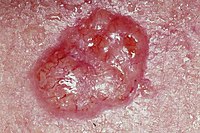
Photo from wikipedia
DOI: 10.1097/JW9.0000000000000020 Dear Editors, Gorlin syndrome (GS), or nevoid basal cell carcinoma syndrome, is caused by pathogenic variant in the PTCH1 tumor suppressor gene and characterized by basal cell carcinomas… Click to show full abstract
DOI: 10.1097/JW9.0000000000000020 Dear Editors, Gorlin syndrome (GS), or nevoid basal cell carcinoma syndrome, is caused by pathogenic variant in the PTCH1 tumor suppressor gene and characterized by basal cell carcinomas (BCCs), keratocystic odontogenic tumors of the jaw, medulloblastomas, and other cutaneous and skeletal features. GS is typically inherited but may be caused by a de novo mutation during development in 20 to 30% of cases.1 During their premenopausal years, affected women may develop ovarian fibromas (OFs), causing frequent urination, abdominal pain, and ovarian torsion. We aimed to evaluate the correlation of OF with cutaneous disease burden in females with GS. A retrospective cross-sectional analysis was conducted using data from the national patient registry established by Gorlin Syndrome Alliance and Stanford University, which contains patient demographics, disease manifestations, and therapeutics received. Participants met clinical diagnostic criteria2 and/or were genetically confirmed. The registry consisted of 202 adults. Of 116 females, 51 (44.0%) reported OF (Table 1). The proportion of women with high BCC burden (250+ BCCs) was significantly greater in the OF group (P = .025) (Table 2). Median age at evaluation was comparable among cohorts. Median age of diagnosis was younger in the OF group (14 vs 18 years, Table 1). Jaw cysts, a common tumorigenic manifestation utilized as control, had no correlation with BCC burden (P = .624) (Table 2). The proportion of women with OF on vismodegib, a hedgehog signaling inhibitor used to treat aggressive cutaneous disease, was significantly higher than in women without OF (58.3% vs 33.3%, P = .009) (Table 1). Our results demonstrate that women with OF have higher BCC burden are diagnosed younger and are more likely to be on systemic therapy. This association between OF and increased BCCs appears to be specific, rather than a general reflection of increased tumorigenesis. We theorize patients with more deleterious mutations3 or those with de novo mutations occurring earlier in embryogenesis may be more likely to develop OF and greater BCC severity. GS is a clinically heterogeneous disorder, with lifetime number of BCCs varying from less than 10 to over 2000.4 The wide spectrum of phenotypic severity in GS highlights the importance of risk stratification. Besides radiation, UV exposure, and immunosuppression, other predictors of disease burden in GS are not well-established. Our study demonstrates OFs may be an important surrogate marker for BCC
Journal Title: International Journal of Women's Dermatology
Year Published: 2022
Link to full text (if available)
Share on Social Media: Sign Up to like & get
recommendations!